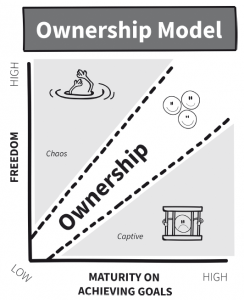
Corporate training has come a long way. Our attitudes toward training should also move forward.
To train or not to train employees
When employees resign after a company invests in employee training, it is not just a gut punch, it’s a kick in the ding- ding when the manager is down. With the average length of career tenures getting shorter, there are numerous leaders who are fearful of investing budgeted straining dollars into their employees.
A generation or two ago, the average tenure for employees was 10 – 15 years with a single company and employee investments were easy to justify. With today’s tight labor market and a different generation of workers, it isn’t unusual for employees to shift every two years because of the desire to work on new products or technology. Today’s workers wants to expand their skill set. Todays workforce wants to learn and does not want to remain stagnant.
The employer mindsets have become insecure because of this. They are afraid that if the company invests in the employee, the employee becomes more valuable. Training makes the employee more attractive to higher-paying competition. The fear is that the investment of training and certifications, all paid for by the current employers profits can walk out the door.
I call this shortsighted leadership, and the term leadership is used pretty loosely here. To the managers who don’t want to invest in training because of a few bad apples, consider this to be the same attitude as the HR folks we are all resentful of. These same HR folks put red tape and rules into place for the entire workforce when a few bad players weren’t managed correctly. Because one or two employee came to work with dilated eyes (who wants to get high by themselves?), in typical HR fashion the thing to do would be to administer regular drug tests for everyone. One bad apple shouldn’t spoil it for the rest of the bushel.
Training not only makes employees valuable TO THE COMPANY, training can increase individual productivity and loyalty to the company. If a manager is worried about making an employee more valuable to the competition, the manager should be reminded that a trained employee is more valuable to the current employer as well. According to a trends report from a recent FORTUNE 100 Best Companies to Work For article, the best companies are:
- Offering 66.5 hours of training annually for salaried employees
- Offering 53 hours of training for hourly employees
- Fill on average 31% of open positions with internal candidates

Not all training requests are cray-cray boondoggles.
Maybe you are thinking about expensive classes where employees are away from the office on some Vegas boondoggle. Yes, we have all seen the cray-cray expense reports, but again, we shouldn’t let a bad expense report ruin it for everyone else. This my friend is called “prejudice”. If your company doesn’t have the resources to send an employee to off-site training, wants to keep employees on campus, or isn’t able to have employees out of the office for the extra travel days, online resources are a good alternative.
Earlier generations viewed classroom learning with textbooks and a classroom as the ONLY way to train. Today, online training has become the new black. Many people are receiving accredited degrees online and using YouTube to learn how to do everything from cooking to changing the oil on their specific model car to advance skills in EXCEL. Online training can be particularly appealing to employees because they can study at their own pace and retake a class or replay a video they don’t understand. For me, YouTube is the very first place I go when I want to learn more about ANYTHING.
Leadership should take notice that a vast majority of the workforce is hungry to grow and will stick around when presented the opportunity to develop new skill sets. Seeing anything less is a miss. If we train a department of 20 employees, it is usually just one or two folks out of the 20 who leave. These folks were probably going to leave regardless of whether or not they received the training and we shouldn’t make the correlation between training and leaving. These employees didn’t leave because of the training. These employees were going to leave. Try not to think about how much you spent on the ungrateful few that left. Think about how much benefit was reaped across the department and the long-term gain.
Many employees leave because they are not challenged and did not feel they were growing professionally. If employees are stuck on the same product, service or technology year after year, of course they are going to get bored. If we can give them training, we can expand their skill set and keep careers interesting.
As an HR professional, I don’t create policy in fear of a few bad apples or experiences. I need to trust that our employees are going to do the right thing a majority of the time. We shouldn’t EXPECT 100% of the workforce to stick around for the rest of their careers. This attitude is arrogant and in most cases not reasonable. There is no single company decision that is going to make everyone happy. If there is one thing I learned in HR is that no matter what decision you make, there will be employees that find fault or complain. Provide a free breakfast and someone will wonder about why there isn’t a free lunch. Provide a MacBook and someone will say there isn’t enough memory.
Most of the population will be grateful. We need to focus and invest in this group. If we create policy for the bottom 10%, we will certainly drive away the top performers and this is the last thing we want to do.
At the end of the day, we need to make decisions for the sane and rational 90% of the company, not the 10% that doesn’t appreciate it. I count myself lucky when the ingrates leave the company on their own volition. If that means we lose 10% and they take their negative attitudes with them, I consider that a long-term win. The damage this 10% will do over the long run can’t be measured. If they want to take the training and run, I will be perfectly content watching this demographic go to the competition because they probably weren’t the right fit for us and can be the cancer at the competition with their bad attitude. We still have the 90% of the population that matters. If someone doesn’t want training, that is a sign. But if someone does want training, we should be so lucky.
Business & Finance Articles on Business 2 Community(31)









